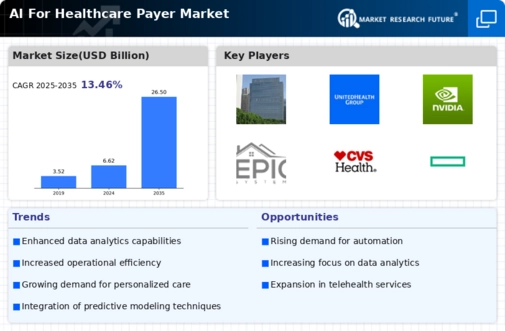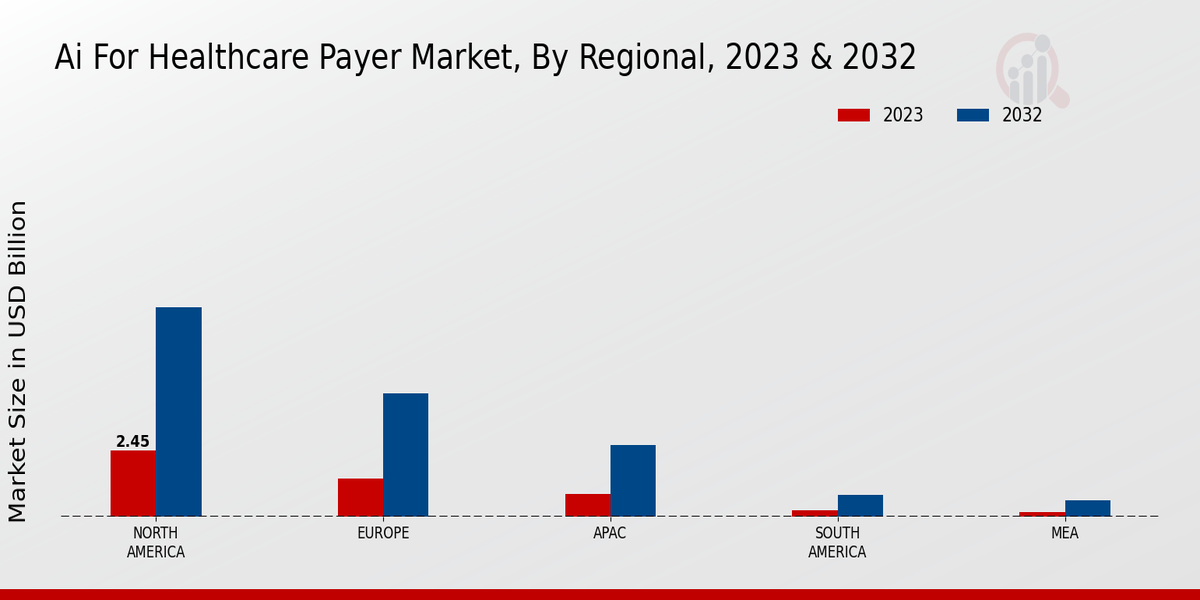Rising Data Availability
The proliferation of electronic health records (EHRs) and other digital health data sources significantly impacts the Global AI For Healthcare Payer Market Industry. The availability of large datasets enables AI algorithms to learn and improve, enhancing their predictive capabilities. Payers can leverage this data to identify trends, optimize resource allocation, and improve patient care. As data becomes increasingly accessible, the potential for AI applications in healthcare payer systems expands, driving innovation and efficiency. This trend is likely to contribute to the market's projected compound annual growth rate of 13.46% from 2025 to 2035.
Enhanced Patient Outcomes
Improving patient outcomes remains a central focus within the Global AI For Healthcare Payer Market Industry. AI technologies facilitate personalized medicine by analyzing vast datasets to tailor treatment plans to individual patient needs. For example, AI algorithms can assess genetic information alongside clinical data to optimize therapeutic strategies. This capability not only enhances patient satisfaction but also reduces the overall burden on healthcare systems. As the market evolves, the emphasis on AI solutions that contribute to better health outcomes is likely to drive further investment, contributing to the anticipated growth to 26.5 USD Billion by 2035.
Market Growth Projections
The Global AI For Healthcare Payer Market Industry is poised for substantial growth, with projections indicating a rise from 6.62 USD Billion in 2024 to 26.5 USD Billion by 2035. This growth trajectory reflects a compound annual growth rate of 13.46% from 2025 to 2035, highlighting the increasing reliance on AI technologies within the healthcare payer sector. The expansion is driven by various factors, including the need for cost efficiency, improved patient outcomes, and the integration of advanced technologies. As the market evolves, stakeholders are likely to explore innovative AI applications to enhance their operations.
Regulatory Support and Compliance
The Global AI For Healthcare Payer Market Industry benefits from increasing regulatory support aimed at integrating AI into healthcare systems. Governments are recognizing the potential of AI to improve efficiencies and patient care, leading to the establishment of guidelines that encourage innovation while ensuring patient safety. For instance, regulatory bodies may provide frameworks that facilitate the adoption of AI technologies in claims processing and fraud detection. This supportive environment is expected to foster growth, as compliance with regulations becomes more manageable, thereby attracting more stakeholders to invest in AI solutions.
Growing Demand for Cost Efficiency
The Global AI For Healthcare Payer Market Industry experiences a growing demand for cost efficiency as healthcare costs continue to rise. Payers are increasingly adopting AI technologies to streamline operations, reduce administrative burdens, and enhance decision-making processes. For instance, AI-driven predictive analytics can identify high-risk patients, enabling proactive interventions that reduce hospitalizations and associated costs. This trend is underscored by the projected market value of 6.62 USD Billion in 2024, indicating a robust shift towards AI solutions that promise significant savings and improved resource allocation.
Integration of Advanced Technologies
The integration of advanced technologies such as machine learning and natural language processing is transforming the Global AI For Healthcare Payer Market Industry. These technologies enable payers to automate complex processes, such as claims adjudication and customer service inquiries, leading to faster response times and improved accuracy. For example, chatbots powered by natural language processing can handle routine inquiries, freeing up human resources for more complex tasks. As these technologies continue to evolve, their adoption is expected to accelerate, further enhancing operational efficiency and driving market growth.















